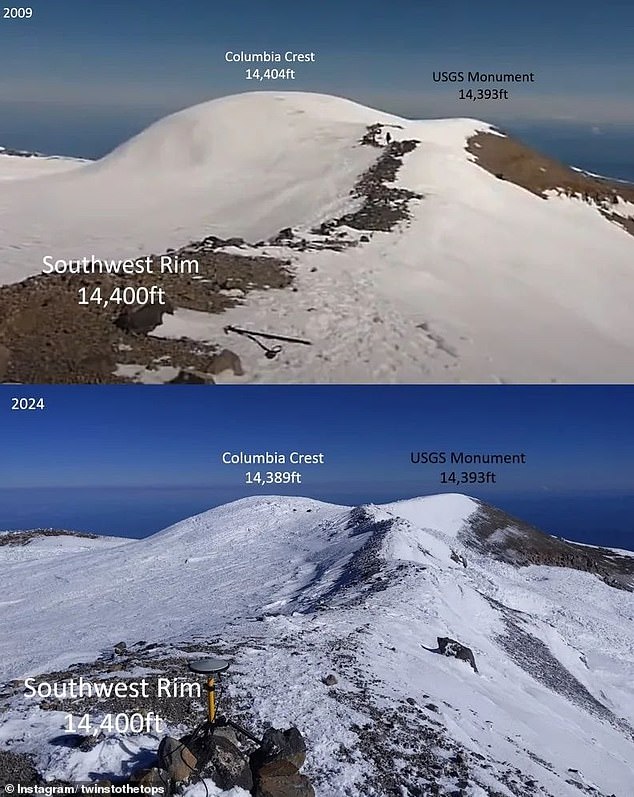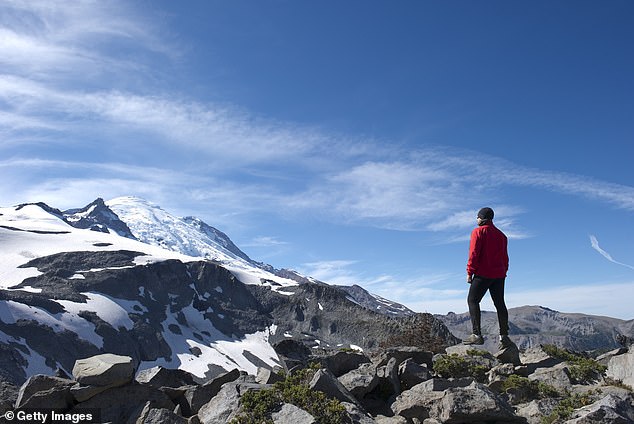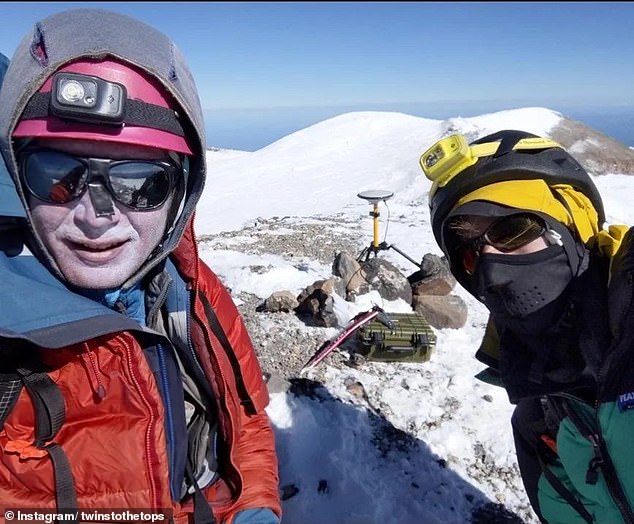Scientists discover Washington’s tallest mountain is SHRINKING
Scientists have made a surprising discovery while exploring Washington’s tallest mountain: It’s shrinking.
Mount Rainier historically stood at 14,410 feet, but researchers found that the volcanic mountain has shrunk by 10 feet since 1998.
The drop in elevation was due to a drop in Rainier’s old ice sheet, Columbia Crest, which melted nearly 21 feet.
An increase in fossil fuels and a warming climate have likely contributed to the loss, with researchers reporting that Mount Rainier has lost 42 percent of its glacial ice over the past 120 years.
Mount Rainier offers Washington’s highest peak, but has lost 42 percent of its glacial ice in the past 120 years
Mount Rainier is known for having the highest volcanic peak in the continental US and the largest glacial cave system in the world.
But the discovery that Erick Gilbertson, a mountain climber and mechanical engineer, made on August 28 has changed the landscape of the Pacific Northwest.
“The summit area of Mount Rainier has a crater rim that melts into rocks every summer, but historically there has always been a permanent ice dome on the western edge of the rim,” he said in an interview. blog post.
Mount Rainier was first measured in 1914, with the Columbia Crest considered the highest peak in Washington in 1956.
But Gilbertson’s new measurements suggested that Columbia Crest was displaced from the top spot in 2014, surpassed by the southwestern crater rim which is 4,300 meters high.
The height of Washington’s mountain peaks fluctuates throughout the year as ice builds up on the peaks during the winter and melts in the summer. This makes it essential that surveyors document their elevation when the ice sheets are at their lowest.
And that’s why Gilbertson made the trip this summer.
“Measurements at this time of year mean that seasonal snow does not count towards summit height,” Gilbertson said Newsweek.

Mount Rainier’s peak, Columbia Crest, the highest in the state, has shrunk by nearly 20 feet since 1998

About 40 percent of Washington’s mountain peaks have lost volume since 1984
His discovery at Mount Rainier led him to wonder whether other ice-covered peaks in Washington had undergone a similar transformation and visited these peaks to confirm his suspicions.
On Rainier’s northern slope is Liberty Cap, which has melted more than 25 feet since the last measurement in 2007, while Eldorado Peak south of Diablo Lake is 20 feet lower.
Gilbertson also checked Colfax Peak on the western slope of Mount Baker, and while the elevation appears to be the same, the lowest area between next to the summit has melted more than 16 feet in the past two years.
Mauri Pelto, a professor at Nichols College in Massachusetts, began taking annual measurements on glaciers on Washington’s mountaintops, but said that since 1984, about 40 percent have lost their volume.

Eric Gilbertson (left) hiked Mount Rainier in August and September and used a GPS survey unit to determine the mountain’s height
“Obviously we’ve seen a lot of it disappear,” said Pelto, who teaches at Nichols College in Massachusetts and returns to Washington every year for work.
He told the Seattle Times that the vast majority of melting occurred in the past 24 years, indicating that it is accelerating.
“We will still have mountains; We will still have snow in the winter,” he said. “But without the glaciers you have lost an important dynamic, and the mountains will be poorer for it.”
Gilbertson’s new measurements of Columbia Crest have not yet been officially confirmed and are still being studied by Mount Rainier National Park, which will decide whether to conduct a new survey of the mountain or accept his findings.
Although Gilbertson did not state the cause, meteorologists have attributed the melting spikes to a warming atmosphere caused by fossil fuels.
Year after year, researchers around the world have reported heat records, with this summer being the hottest in 175 years.
At this rate, Earth’s surface warming could increase by 2.7 degrees Fahrenheit as early as 2040 — which is considered a critical climate threshold and will continue to melt ice and snow-capped peaks around the world.
“There aren’t many glaciers in the North Cascades that can survive the next 30 years,” Pelto said.
